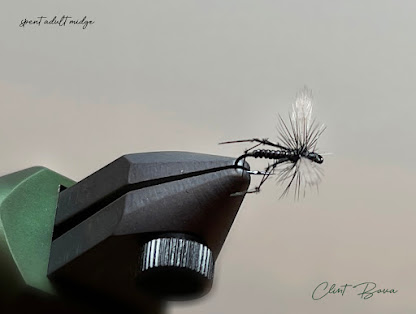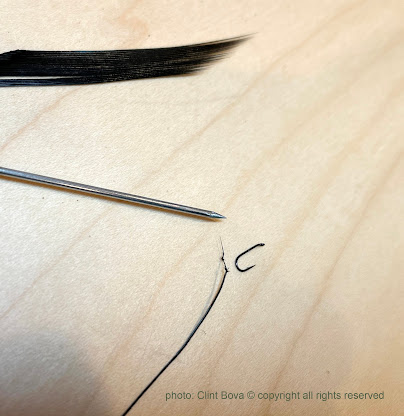Adult Spent Midge | For Selective Trout
Midges make up a large portion of the trouts diet during pretty much all their life cycles. Adult midges that are crippled, spent, or struggling in the surface film typically have wings and legs splayed. Often even the abdomen is partially submerged while the rest of the insect is still struggling to get out of the water. Unlike an emerger the fully formed adult is simply stuck in the film and in escape mode with a lot of fluttering and awkward contortions using its legs as pry bars. If you have read the book Modern Midges by Takahashi and Hubka it's a great resource that illustrates this concept in the adult phase in many frames. The adult midge struggling in the surface film triggers a trout to feed because they do not have to use a lot of energy to simply tip and sip this morsel. Similarly the same notion holds true for mayfly spinners. They dial in on these insects because they are vulnerable and easy pickings.
Often even the abdomen is partially submerged while the rest of the insect is still struggling to get out of the water. Unlike an emerger the fully formed adult is simply stuck in the film and in escape mode with a lot of fluttering and awkward contortions using its legs as pry bars. If you have read the book Modern Midges by Takahashi and Hubka it's a great resource that illustrates this concept in the adult phase in many frames. The adult midge struggling in the surface film triggers a trout to feed because they do not have to use a lot of energy to simply tip and sip this morsel. Similarly the same notion holds true for mayfly spinners. They dial in on these insects because they are vulnerable and easy pickings.
The following pattern, the Adult Spent Midge, is something that I've modified over time using knotted pheasant tail legs, hen tip wings, and a dyed quill abdomen. (click on any of the images below to magnify)
Fig 1.
Tie in quilled abdomen followed by micro knotted pheasant tail, secure hen tips so they splay horizontally tipping ever so slightly up. Build up a thorax using black waterproof Superfine Dubbing and remember these insects are very gossamer and streamline so tread lightly on the dubbing.
Fig 2.
Pay close attention to the proportion of knot segments this is a short shank TMC 531 but you can use a TMC 100 or 101, two legs on either side is sufficient and should extend beyond the the hook no more than two to three hook eye distances.
Fig 3.
Micro knotted pheasant tail for a TMC 531 #22 takes some practice using tweezers and a magnifier but with a little practice becomes quite a meditative task in front of a fireplace.
Fig 4.
Another view illustrates wing position and legs relative to the hook.

Fig 5-9.
The above photos show a hackle collar tied in wrapping across dubbed thorax ball
1st wrap in the rear
2nd wrap across diagonally
3rd wrap across in opposite direction to form an overall criss-cross wrap
now secure hackle and whip finish.
This hackle collar technique is one I use for mayfly spinners on the thorax around the hen tip wings as well. It's a little difficult at first especially at this size but the dubbing ball causes the hackles to squirt forward and backwards making for a very floatable fly. You can choose to trim the lower hackle fibers making the thorax sit right in the surface film or leave them. I typically like to fish it in the surface film so with I cut a V notch or trim it back.
Adult Spent Midge
Hook: TMC 531 (as seen) or TMC 101
Thread: Veevus black 16/0
Abdomen: Black quill
Thorax: Black Dry Fly Super Fine Dubbing
Wings: Medium Dun Hen Tips
Legs: Black micro knotted pheasant tail
Hackle: Black
This is a deadly midge pattern that I use all the time on the Grand River when the hatch is off and the big guys are sipping in the shadows and overhangs throughout the day. Midges are a bit like trout popcorn, they are addictive to tie as well!
~Clint Bova www.cjbovarods.com















